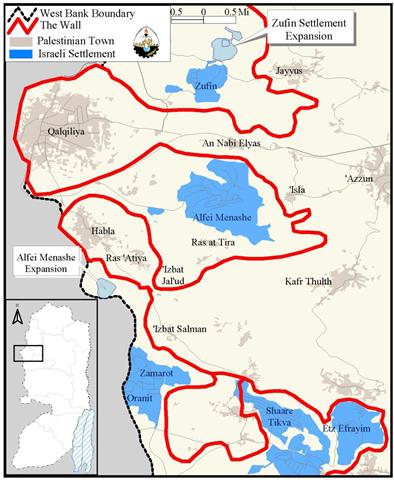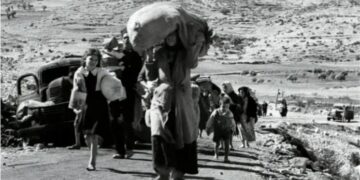Print Frinedly in PDF Format: Isolated Lands, Segregated Communities
The 'Green Line' is the internationally recognized border between Israel, the West Bank, and the Gaza Strip as based on UN-brokered armistice agreements of 1949. The International Community demonstrated its recognition of this border in UN Security Council Resolution 242 (1967) which requires the '[w]ithdrawal of Israel armed forces from territories occupied in the recent conflict.'
In utter disregard for this internationally recognized border, Israel began, in June 2002, construction of a Wall on Palestinian land inside of, and not on, the Green Line. The Wall juts up to 21 km (13 miles) into the West Bank and Gaza Strip, grabbing open spaces, environmental resources and Israeli settlement areas. Palestinian communities, meanwhile, have found themselves placed in shrinking ghettos, isolated from their lands and segregated from neighboring communities. The Wall plan also includes the appropriation of Palestinian territory in the eastern West Bank (the Jordan Valley) where Israeli checkpoints and settlements completely dominates the Palestinian population.
Although Israel utilized the pretext of 'security' to rationalize the construction of the Wall, the Wall's path betrays its real purpose: a land grab aimed at illegally annexing as many settlements as possible to Israel. 160 illegal Israeli settlements with a population of 393,500 (87% of the settler population) are on the Israeli side of the Wall. The Wall appropriates additional areas adjacent to the settlements. Israel has already begun to construct new settlements and expand existing ones on this land.
When complete, the Wall will de-facto annex nearly 37% of the West Bank and Gaza Strip to Israel in defiance of international law. Indigenous Palestinians will be relegated to cantons and ghettos on 12% of their historic territory.
Isolated Lands, Segregated Communities
Israel's Wall runs along the Green Line for a quarter of its length. The remaining wall cuts violently into the West Bank and Gaza Strip, isolating and appropriating some of the most fertile areas available to Palestinians. The loss of these resources has deepened the humanitarian crisis in a Palestinian population highly dependent on agriculture, grazing and access to water.
The Wall in the Gaza Strip receives little attention but affects Palestinian communities in its path as severely as those in the West Bank. Most of the Wall in Gaza runs along the border, but approximately 9,000 Palestinians are isolated in tiny ghettos controlled by Israeli soldiers.
The Wall affects approximately 47% of the total Palestinian population. The 150,000 who are isolated by the Wall or contained in Israeli-controlled ghettos cannot enter or leave their communities without permission from Israeli soldiers.
|
Components of the Wall |
|
Wall Components: Generally, the Wall consists of two types of structures:
The path of the Wall also features 100-300 ft. wide 'buffer zone' including military surveillance paths, ditches, and electrical fencing. |
Access Denied
Palestinians can only reach lands and communities isolated by the Wall by presenting special permits at a limited number of gates and checkpoints controlled by Israeli soldiers. Issuance of permits is subject to security clearance from Israeli soldiers and proof of land ownership. The application process for land title documents and permits is long, tedious and expensive and Palestinian applications are often denied without reason.
Palestinians who lack permits are prohibited from accessing their lands and may lose the only source of income for their families. In addition, under old Ottoman land laws, if Palestinian properties are not cultivated for three consecutive years Israel can confiscate the lands without compensation to the owner. As the Wall project enters its third year, increasing amounts of Palestinian land are under threat of outright confiscation by Israel
The Segregation Wall and international Law
In July 2003, the International Court of Justice (ICJ) passed an advisory opinion declaring that Israel's Wall is illegal. The Court based its decision on existing international law, including the Fourth Geneva Convention, the Hague Regulations, various human rights treaties, and UN Security Council resolutions. The Wall violates the Right to Self-Determination, the Law of Belligerent Occupation, and Human Rights Law.
The Court confirmed that the entire West Bank and Gaza Strip, including East Jerusalem, are territories under occupation by Israel, and are therefore protected by the Fourth Geneva Convention. This makes all Israeli settlements and population transfers illegal as Article 49 states 'The Occupying Power shall not deport or transfer parts of its own civilian population into the territory it occupies'.
The ICJ believes that the wall is an attempt to connect settlements and settlers to Israel,
creating 'facts on the ground' and de-facto annexing Palestinian land, which will have a significant impact on future negotiations regarding borders. Israel is also bound to the Hague Convention of 1907, which it violates by confiscating land to construct the wall on.
The wall results in the violation of human rights including the right to freedom of movement,access to holy places, to work, to health, to education, and to an adequate standard of living. The ICJ decision upholds the right to self-determination of the Palestinian people, which they are prevented from exercising by the wall's disruption of the territorial integrity and unity of the population. 'Self-defense' or 'state of necessity' can not be used as justification for violating this right and other international legal principlesand therefore Israel must cease construction and all other states must refrain from supporting Israel in building the Wall.
Case Study: The Village of Jayyus
Tawfiq Salim is a farmer from Jayyus whose land has been destroyed as a result of the wall. The bulldozers uprooted 750 olive trees which were taken to Israel to be sold. Jayyus is an area that has been heavily affected, due to its proximity to the illegal Israeli settlement of Zufin. Israel intends to double Zufin's size and build 1,500 new homes in the settlement. 70% of Jayyus lands, including vast agricultural areas and six wells, have been appropriated. Israeli soldiers control two gates in the Wall, but like Tawfiq, most residents have been denied permits and are cut-off from their lands. See Map of Settlement expansion in Jayyus Village
The Wall and the International Community
The only peace agreement currently on the table, the Roadmap peace plan, calls for the staged withdrawal of Israeli soldiers and settlers from the West bank and Gaza Strip. The Wall, however, represents a unilateral Israeli action creating additional military infrastructure in occupied Palestinian territory.
The sponsor of the Roadmap, the 'Middle East Quartet' (United Nations, European Union, United States and Russia) has consistently argued that 'no party should undertake unilateral actions that could prejudge the resolution of final status issues.
These repeated statements, however, have come to nothing. The Quartet has simply refused to enforce Israel's obligations. In fact, the United States has consistently acted to undermine the authority of the Quartet in implementing the Roadmap.
As Israel's only long-term strategic ally, the role of the United States in supporting the occupation of the West bank and Gaza Strip has been crucial. The Us has provided Israel an average of over $3 billion of aid per year (including at least $2.6 billion in military aid). US political and diplomatic support has allowed Israel to ignore countless censures by the United Nations and was instrumental in Israel's flouting of the ICJ decision.
In April 2004, George W. Bush exchanged letters of support with Israeli prime Minister Ariel Sharon. Bush endorsed the route of the Wall as a permanent boundary, stating: 'In light of new realities on the ground. . . it is unrealistic to expect that the outcome of final status negotiations will be a full and complete return to the armistice line of 1949.'
Prepared in cooperation with:
Bush's proclamation abandons the international consensus on the border as demarcated by the armistice line, allows for large settlement blocs to be annexed by Israel and is an endorsement of the illegally constructed Wall.
Without immediate international action, Israel will continue to construct the Segregation Wall under US patronage. The results will be devastating for Palestinian society and for the prospects of a lasting peace in the Middle East.
Print Frinedly in PDF Format: Isolated Lands, Segregated Communities
::::::::::____
Notes:
[1] Legal Consequences of the Construction of a Wall in the Occupied Palestinian Territory. Advisory Opinion July 9, 2004 para. 78
[2] supra note 1, para. 120
[3] Geneva Convention Relative to the Protection of Civilian Persons in time of war. Article 49.
[4] supra note 1, para. 119
[5] supra note 1, para. 121
[6] Hague Convention IV The Laws and Customs of War on Land. 1907. Article 46
[7] International Covenant on Civil and Political Rights
[8] supra note 1, para. 129
[9] International Covenant on Economic, Social, and Cultural Rights and the United Nations Convention on the Rights of the Child
[10] supra note 1, para. 118
[11] supra note 1, para. 122
[12] supra note 1, para. 142
[13] supra note 1, para. 145
[14] supra note 1, para. 146
[15] Quartet Statement. The Electronic Intifada. March 5, 2004.'
Prepared by:
The Applied Research Institute – Jerusalem











